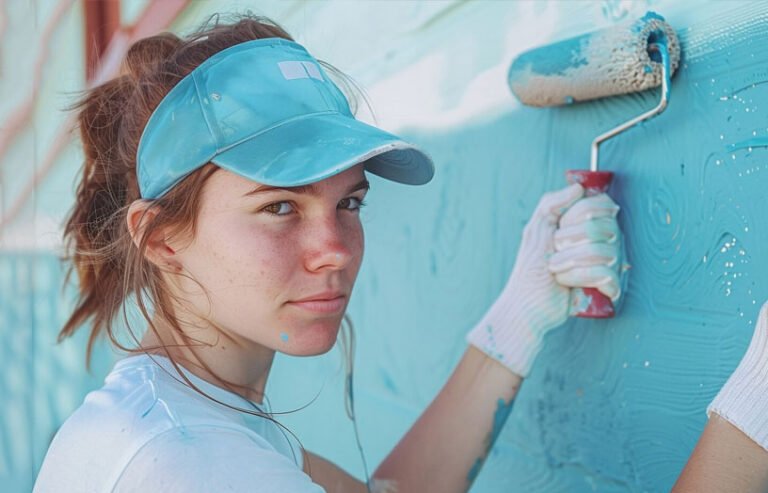Key Takeaways:
- Learn the importance of proper preparation before painting your home’s exterior.
- Get tips on selecting the correct type of paint and color for different house exteriors.
- Understand crucial techniques for achieving a professional finish.
- Discover maintenance tips to keep your exterior paint looking fresh longer.
Why Exterior Preparation is Crucial
Thorough preparation is over half the battle when painting your home’s exterior. Please prepare correctly to avoid peeling, cracking, or uneven paint application, ruining even the highest-quality paint. Therefore, it’s crucial to start by thoroughly cleaning the exterior surfaces. A pressure washer can be particularly effective for removing dirt, mildew, and old flaking paint. These initial steps ensure the paint will adhere properly and last longer.
After cleaning, it’s essential to address rough spots by sanding them down. Additionally, filling in cracks, holes, and other imperfections with the appropriate fillers can significantly improve the final appearance. Priming the surface is equally important, especially if you’re making a drastic color change or dealing with weathered wood. Priming helps in better paint adhesion and longevity. These meticulous steps may seem time-consuming, but they ultimately pay off with a smoother and more durable finish. For more details on eco-friendly exterior house painters, consider services emphasizing sustainable practices while delivering a professional look.
Selecting the Right Paint and Color
Choosing the right type of paint for your home involves understanding the specific needs of different exterior materials. For instance, stucco, wood, and vinyl each have unique requirements. Acrylic latex paint is generally recommended for most exteriors due to its durability, flexibility, and easy maintenance. If your home has wooden features, you might need a paint that offers better moisture protection.
The finish you select also plays a significant role. Matte finishes can hide imperfections but might require more frequent maintenance due to their susceptibility to mildew. Satin finishes strike a balance between hiding flaws and being easy to clean, making them popular. Glossy finishes, although more challenging to apply evenly, offer excellent durability and are ideal for areas that need frequent cleaning, such as trims and doors.
Color selection goes beyond just aesthetic appeal. Light colors can reflect more sunlight, helping to keep your home cooler, which is particularly beneficial in warmer climates. Meanwhile, dark colors absorb heat and can warm your home during the colder months. Additionally, examining your home’s architectural style and existing neighborhood trends can provide valuable insights. Choosing a harmonious color scheme not only enhances the look of your home but also maintains neighborhood aesthetics.
Essential Techniques for a Professional Finish
1. Priming
Using a high-quality primer is essential for achieving a professional finish. Primers ensure better paint adhesion by creating a uniform surface for the paint to adhere to, thereby extending the paint job’s life. They are handy for covering imperfections and providing a solid base for the topcoat. Always choose a primer compatible with the type of paint and surface you’re working with. For instance, using an oil-based primer under latex paint can lead to cracking and peeling.
2. Brush and Roller Usage
Different surfaces and paint types require specific brushes and rollers to avoid streaks and ensure maximum coverage. Synthetic brushes are suitable for latex paints, while natural bristle brushes are ideal for oil-based paints. Rollers are practical for large flat surfaces like walls, but use ones with the appropriate nap length for the surface texture. For example, a shorter nap roller works well on smooth surfaces, while a longer nap is better for textured surfaces.
3. Consistent Painting
Maintaining a wet edge is critical to avoiding lap marks and ensuring uniform coverage. Work in manageable sections, typically four feet by four feet, and always paint from the top down to prevent drips from marking freshly painted areas. Overlapping each pass by about an inch can help maintain a wet edge and produce high-quality results.
4. Layering
Applying multiple thin layers of paint rather than one thick layer yields a more durable and aesthetically pleasing finish. Thick layers are prone to sagging and can lead to an uneven surface. Thin layers dry more evenly and adhere better, making them less likely to peel or crack over time. Allow each layer to dry thoroughly before applying the next to ensure the best results.
Maintaining Your New Exterior Paint
Maintenance is crucial for keeping your newly painted home looking fresh and vibrant. Regular cleaning, such as using a mild soap and water for washing, helps remove the buildup of dirt and grime. Completing this simple task can significantly extend the longevity of your paint job by preventing stains and mildew.
Promptly repair any damages, such as chips or cracks, to prevent further deterioration. Minor imperfections can quickly escalate if left unattended, leading to more extensive repairs. Touching damaged areas with leftover paint can keep your exterior uniform and well-maintained.
Conclusion
Properly preparing and painting a home’s exterior requires attention to detail and the right techniques. By following these essential steps, homeowners can achieve a professional and long-lasting finish that enhances their home’s appearance and withstands the elements. Remember, thorough preparation, selecting the right paint and color, and maintaining the finish are crucial for a beautiful and durable exterior paint job.

